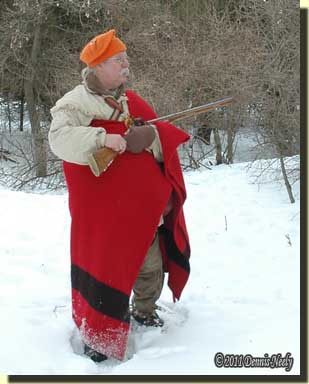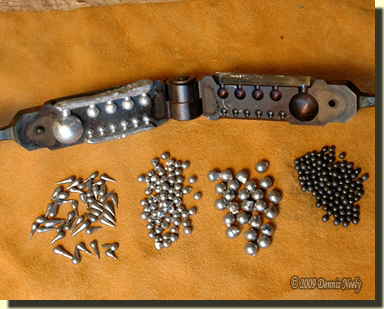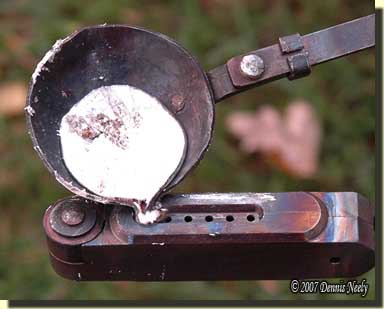Snowflakes drifted in calm air. The white blanket, laid upon the glade an hour or so before dawn, proved a pleasant surprise. A hint of aromatic red cedar teased the nose. Two square-cut trade shirts, a wool sleeveless waistcoat and a linen hunting shirt seemed proper attire for that mild January jaunt, in the Year of our Lord, 1796.
A measure of drip shot rattled down the bore of a Northwest gun, called “Old Turkey Feathers” by the hired hunter for Samuel the Trader’s post. The death bees swarmed on the tight-packed wadding, emitting hollow, muffled pops. The hickory rammer thumped twice on the wadding that held the eternal messengers at bay; the rod clicked and clapped as it slid into the ribbed brass ferrules.
Down the hill and around the bend in the cedar growth, half-filled cottontail rabbit tracks defined an erratic path through clumps of bent-over prairie grass. Back and forth they wandered. The woodsman tracked the rabbit with his eyes, always searching ahead. The course entered the first stand of cedars, then disappeared in the barren ground beneath the trees’ outstretched branches. The tracks resumed, vanished, angled right, disappeared, then meandered into a snowy thicket.
Fingers tingled. A cold nose dribbled. Yet, the post hunter’s upper body felt as if he was sitting next to the hearth in the trader’s cabin. The rabbit’s journey paused beneath the wild apple tree, the resting spot fresh, packed some from body warmth, dappled with round, black leavings.

The hunter stood in silence, his eyes sorting out the path, suspecting the rabbit might be sitting not too far away. In the solitude of the moment, he whispered the familiar prayer, “A clean kill, or a clean miss. Your will, Oh Lord.”
Twenty paces distant, while casting in a small circle in hopes of regaining lost tracks, a brown streak bounded from a small raspberry patch. The English flint snapped to attention; the tarnished brass butt plate jumped to its rightful place. A chilly cheek pressed against the cold stock.
The rabbit zigged right, bounded left, then ran under a ground-hugging hemlock bush. The turtle sight pursued, racing to catch up. Fleeting fur crossed a wagon-bed-sized clearing. Snow shook free from a prairie grass clump. The smoothbore’s muzzle caught the flipping cotton tail an instant before the rabbit dove under a dead cedar tree, sprawled on the ground by a long-forgotten ice storm. Amongst the tangle of dead branches, twisted grasses and intertwined raspberry switches, an abandoned woodchuck hole dashed any chances of rabbit stew…at that moment, anyway…
18th-Century Shot Size Equivalents
Earlier this month, Rancocas responded to “A Tad Late Tuesday” post. A question followed his kind comments:
“What would be the modern equivalent of ‘duck shot’ and another that I sometimes hear mentioned is ‘swan shot’. I’m thinking, maybe, #4 and BB?”
There is no definitive answer to this question. The designations in the trading journals appear to be consistent with hunters’ common choices for the shot size needed to down specific birds or animals. Thus, “swan shot” was used for hunting swans, “duck shot” for ducks, and “buck shot” for deer.
On the one hand, there was no standardization of terms, and on the other hand there was a universal understanding of sorts as to the meaning of each shot-size name. Taken as a whole, the clerks’ letters describing desired trade goods, although sometimes vague, confirm the latter hypothesis.
In hindsight, all three of my alter egos refer to “duck shot” for hunting ducks and wild turkeys. Looking strictly at the historical evidence, this is a mistake with regards to documentation and perceived equivalent modern shot sizes. However the designation might not be with respect to in-the-field experience.
Four decades ago, I hunted ducks, meaning mallards, wood ducks and teal, with #4 lead shot. That size worked best for a clean, efficient taking of those specific types of waterfowl. With the advent of the requirement for non-toxic shot, I gravitated to #3 bismuth. Given the element’s lighter weight, #3 bismuth was equivalent to #4 lead by weight and provided the same results. In addition, the Michigan game regulations require “…no. 4 or smaller shot” for wild turkeys. Here again, #4 lead is my preferred turkey shot, so when hunting turkeys, as I was in that post, I refer to the shot as “duck shot.”
I now realize I should rethink that designation from an historical context…you folks are killing me here. But this just points up one of the basic principles in traditional black powder hunting, that being failures and short comings, both big or small, are nothing more than successes in disguise.
In Colonial Frontier Guns, T. M Hamilton wrote: “Before 1665 shot (as distinguished from swan and buckshot, which have always been cast in gang molds) was made by the laborious process of cutting sheet lead into cubes and then tumbling them in a barrel to more or less round off the corners…”

After 1665, “…his Highness, Prince Rupert…revolutionized the process…Rupert shot was made by placing a brass, colander-like, dish, but with a heavy rim to hold the heat, some ten inches or so above a pan of water. Live coals were place in the colander to heat it; and melted lead, fluxed with arsenic [do not try this!], was then poured into the colander, trickled down through the coals and through the holes, falling as droplets into the water. The result was shot, not perfectly round, but ovoid, almost heart-shaped, in cross section, with a small dimple on the more flattened side…
“This, then, was the dominate type of shot used until the invention of drop shot in 1769, when William Watts is said to have dreamed that he was caught out in a hailstorm of perfectly round lead pellets. The story is that he kept thinking about these round shot and began experiments, dropping molten lead through a colander from the tower of a church until he found that a free fall of 200 feet into a tub of water produced perfect shot…” (Hamilton, 130 -132)
While describing found artifacts in Voices from the Rapids, Alan R. Woolworth and Douglas A. Burk analyzed shot examples found in the Quetico-Superior Underwater Research Project. Shot sizes varied from location to location. They reported finds by diameter from .130-inch to .220-inch or #4 to F by the American Standard.
Two guns, found the Granite River in 1962, each contained charges of shot that varied in size. “No. 1 contained 31 lead shot which ranged from .140 to .185 inch. The charge weighted .50 ounces…” The cataloged sizes ranged from #3 to BB with the majority being B or BB.
“Firearm No. 2 held a charge of 25 lead shot which ranged between .175 and .220 inch. There was a noticeable cluster of 17 specimens in the range of .195 to .205…” BBB and T in modern shot size.
“…Carl P. Russell’s research shows that “pigeon shot,” “duck shot,” “beaver shot,” and “buckshot” were in use during the early 19th century and doubtless earlier. Unquestionably, pigeon shot would have been the smallest, probably in the size range of No. 8 or 9 shot. Duck shot could well have ranged from about No. 4 to No. 6 shot; and beaver shot was no doubt larger, perhaps in the area of BB and larger. Buckshot, of course, is available in a number of sizes between .250 and .440.” (Wheeler, 81)
I hesitate to include this last quote, but there is method to my madness. First, as living historians, we have to take research within the context of the time it was undertaken. These scuba dives and archeological recoveries took place in the 1960s. The findings were published in 1975. Addressing the common 18th-century names, Woolworth and Birk clearly speculate as to the meaning of the old names, following the practice of assigning names based on the supposed use for the shot sizes.

In the Spring, 2001, edition of The Museum of the Fur Trade Quarterly (Volume 37, Number 1, Chadron, NE), James A. Hanson wrote a short article, “Shot Sizes—What Do They Mean?”
“The earliest shooting sportsmen developed a remarkably logical system that used the names of various game animals to denote progressive shot sizes. In representative fur trade orders from the 17th and 18th centuries, the following shot “sizes” appear: pigeon, duck, gray goose, white goose, beaver, partridge, large buck, small buck, snipe, plover, Bristol, coon, muskrat, and mustard seed. Here are the ones we have identified:
Bristol shot = gray goose = beaver shot = TT or O
Duck shot = white goose shot = No. 1
Pigeon shot = No. 2 or No. 3
Plover shot = No. 4
Snipe shot = No. 5
Swan shot or “swan drops” in the robust words of Shakespearean English, measured out 240 pellets to the pound. By today’s standard it is synonymous with .28 caliber buckshot. The beaver shot of the colonial fur trade was the same as the standard shot used at the time to hunt Canadian geese and was .21 caliber with 544 pellets per pound [No. TT]. There were two sizes of buck shot used in colonial America; small buck was .35 caliber and weighed 112 to the pound, while large buck was .38 caliber and contained 80 balls to the pound. So far no light has come to us on such interesting names as coon shot and muskrat shot” (7 – 8)
Given the sizes attributed by Hanson, coupled with the shot found in recovered smoothbores as reported by Woolworth and Birk, it appears 18th-century woodsmen preferred larger diameter shot. An argument can be made that loading with larger shot brings more versatility, offering greater opportunities for bringing meat to the table. Likewise, the increased pellet count of smaller shot ups the probability of effecting a humane harvest, when matched to a specific game species.
Thus, shot size choice, taken within the ethical constraints of modern game laws, highlights the importance of the trade gun’s effective distance. It is the woodsman’s skill level relative to approaching wild game that neutralizes any adverse effect of such a choice and increases a time traveler’s chance for rabbit stew…
Give traditional black powder hunting a try, be safe and may God bless you.



One Response to A Chance for Rabbit Stew